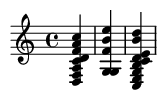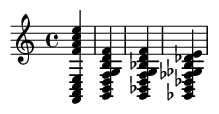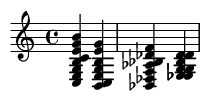Summary:
Bossa nova chord progressions are the heart of the genre, blending the harmonic complexity of American cool jazz with the subtle, syncopated rhythms of Brazilian samba. This guide explores the essential harmonic vocabulary, featuring iconic progressions from Jobim, Gilberto, and others, complete with musical examples to help you understand and play this sophisticated and beautiful music.
Keywords:
bossa nova, chord progressions, Brazilian jazz, jazz harmony, Antonio Carlos Jobim, João Gilberto, ii-V-I, music theory, samba, MusicXML
Introduction: The Birth of a "New Wave"
Born on the sun-drenched beaches of Rio de Janeiro in the late 1950s, bossa nova—or "new wave"—was a musical revolution. Spearheaded by visionaries like composer Antonio Carlos Jobim and guitarist João Gilberto, the movement sought a more intimate and sophisticated alternative to the boisterous samba of the day. They achieved this by infusing the gentle pulse of samba with the rich, extended harmonies of modern jazz. The result is a sound that is simultaneously relaxing and complex, understated and deeply emotional. Understanding its characteristic chord progressions is the key to unlocking the soul of bossa nova.
The Harmonic Palette of Bossa Nova
Bossa nova's harmonic language is built on a foundation of jazz principles, but with a uniquely Brazilian accent. Key characteristics include:
- Lush Seventh Chords: Major seventh (maj7) and minor seventh (m7) chords are the bread and butter, creating a smooth, mellow texture. Unlike basic triads, these four-note chords add a layer of complexity and a "cooler" sound.
- Extended and Altered Harmonies: Composers frequently add 9ths, 11ths, and 13ths to chords, enriching the sonic tapestry. Altered dominant chords (like G7b9 or G7#5) are used to create tension and a more dramatic resolution.
- Chromaticism and Voice Leading: A hallmark of bossa nova is the use of clever chromatic movement, especially in the bassline. Notes often descend or ascend by half-step, creating a seamless and elegant transition between chords.
- The ii-V-I Progression: The cornerstone of jazz, the ii-V-I (e.g., Dm7 - G7 - Cmaj7), is everywhere in bossa nova. However, it's often disguised with extensions, alterations, and substitutions.
- Tonicization and Secondary Dominants: To add harmonic interest, composers often treat a chord as a temporary "home" (tonic) and precede it with its own dominant chord. For example, moving to an Am7 chord might be preceded by an E7.
- Diminished Chords: Used as passing chords, diminished sevenths (like C#dim7) create a sense of suspense and facilitate smooth movement between diatonic chords.
Core Bossa Nova Progressions in Action
Let's move from theory to practice. Here are some fundamental progressions with musical examples that define the genre. Note the use of rich voicings and smooth transitions.
Example 1: The Enriched ii-V-I
This is the engine of most jazz-influenced music. Bossa nova takes the standard ii-V-I and dresses it up with extensions like the 13th on the dominant (V) chord and the 9th on the tonic (I) chord, creating a richer, more quintessential sound.

Analysis: Dm7 (ii) → G13 (V) → Cmaj9 (I). The G13, containing both the 7th (F) and the 13th (E), adds a beautiful tension that resolves satisfyingly to the peaceful Cmaj9.
Example 2: The "Ipanema" Chromatic Turnaround
Perhaps the most famous progression in the genre comes from the bridge of "The Girl from Ipanema." It uses a tritone substitution—replacing a dominant chord with another dominant chord a tritone (three whole steps) away. Here, Gb7 subs for C7, creating a smooth chromatic bassline (G → Gb → F).

Analysis: Fmaj7 → G7 → Gm7 → Gb7. This progression doesn't resolve in a traditional way; it creates a cycle of tension and release that perfectly captures the feeling of longing in the song's melody before returning to Fmaj7.
Example 3: The Chromatic Descending Bassline
A signature sound of Jobim, found in songs like "Corcovado" and "Wave." The bass note walks down chromatically from the root of the tonic chord, creating a feeling of gentle, inevitable descent. Each bass note supports a new, colorful chord.

Analysis: | Cmaj7 | Cmaj7/B | Bbm7 | Eb7 |. The bassline moves C → B → Bb → Eb. The Bbm7-Eb7 is a ii-V that temporarily points towards the key of Ab major, adding a surprising and colorful detour before typically resolving to a chord like Am7.
The Rhythmic Context: The "Batida"
You cannot separate bossa nova harmony from its rhythm. The chords are brought to life by the signature guitar pattern known as the *batida*, pioneered by João Gilberto. This syncopated pattern combines a steady bassline (played by the thumb) with syncopated chords (plucked by the fingers). This creates the gentle, swaying pulse that is instantly recognizable. The rhythm is not aggressive; it floats and breathes, giving the complex harmonies space to resonate.
Iconic Bossa Nova Standards
To hear these progressions in their natural habitat, immerse yourself in the classic repertoire. These songs are masterful studies in harmony and melody:
- "The Girl from Ipanema" (Garota de Ipanema) - Antonio Carlos Jobim
- "Desafinado" (Slightly Out of Tune) - Antonio Carlos Jobim
- "Wave" (Vou Te Contar) - Antonio Carlos Jobim
- "Corcovado" (Quiet Nights of Quiet Stars) - Antonio Carlos Jobim
- "Chega de Saudade" (No More Blues) - Antonio Carlos Jobim & Vinicius de Moraes
- "How Insensitive" (Insensatez) - Antonio Carlos Jobim
Modern Influence
Bossa nova's harmonic sophistication has had a lasting impact. Its chord progressions are a staple in the modern jazz vocabulary and have been absorbed into countless other genres:
- Neo-soul and R&B artists often use bossa-style chords for a smoother, jazzier feel.
- Lounge, chill-hop, and electronic music producers sample and emulate its relaxed aesthetic.
- Pop songwriters and film composers use its harmonic language to evoke sophistication and romance.
Fun Facts
- "Bossa nova" loosely translates from Portuguese to "new trend" or "new flair."
- The style first gained international fame after the 1962 Carnegie Hall concert and the 1964 album Getz/Gilberto.
- The melody of "Desafinado" was a playful response to critics who claimed the new music's singers were out of tune. The harmony cleverly uses notes outside the standard scale to match the theme.
- João Gilberto's revolutionary guitar style was so unique because he mimicked the syncopation of a full samba percussion section with just his thumb and fingers.
Conclusion
Bossa nova chord progressions are far more than a sequence of notes; they are a complete emotional and sonic language. By mastering their blend of jazzy extensions, chromatic voice leading, and gentle rhythmic drive, you gain access to one of the most elegant and enduring sounds in modern music. Whether you're a guitarist, pianist, or simply a curious listener, exploring these harmonies offers a rewarding journey into the heart of the Brazilian sound.
References:
Castro, R. (2000). Bossa Nova: The Story of the Brazilian Music That Seduced the World. A Cappella Books.
Jobim, A. C. & Chediak, A. (2004). Antonio Carlos Jobim: Songbook. Lumiar Editora.
Levine, M. (1995). The Jazz Theory Book. Sher Music Co.
Historical Context and Musical Significance
Bossa nova emerged as a sophisticated fusion of Brazilian samba rhythms and American jazz harmony in late 1950s Rio de Janeiro. Pioneered by João Gilberto's groundbreaking guitar technique and Antonio Carlos Jobim's harmonic innovations, the movement transformed global music by elevating Brazilian popular music to art song status. Unlike traditional samba, bossa nova featured intimate vocals, subtle syncopation, and harmonically rich chord progressions that incorporated extended jazz chords (7ths, 9ths, 11ths) over pared-down rhythmic foundations. This harmonic language became the genre's signature - complex enough for jazz musicians yet accessible through its lyrical sensibility. Landmark recordings like "Chega de Saudade" (1958) demonstrated how chords like Dm9-G13-Cmaj9 could evoke both jazz sophistication and Brazilian melancholy, creating a new paradigm for popular music composition.
Progressive Exercises
Beginner
Practice the foundational ii-V-I progression in C major with basic bossa rhythm:
- Dm7 (X57565) → G7 (3X343X) → Cmaj7 (X35453)
- Right hand: Play chords on beats 1 and 2, mute strings on "and" of 2
- Left hand: Use percussive "bossa claw" (thumb on bass notes, fingers on chords)
Intermediate
Add extensions and chromatic movement from "The Girl from Ipanema":
- F#m7b5 (2X232X) → B7b9 (X2123X) → Em9 (022032) → Ebm9 (XX3131)
- Incorporate thumb independence: Maintain alternating bass (root-5th) while fingers play chord hits
- Practice voice-leading: Keep 9th (G) constant through F#m7b5-B7b9-Em9
Advanced
Master Jobim's "Corcovado" progression with polyrhythms:
- C6/9 (X32230) → E7#9 (021003) → Am11 (5X5555) → D9 (X5455X)
- Layer 3-2 clave rhythm against 4/4 pulse
- Improvise melodic lines using C Lydian-Dorian hybrid scale over changing harmony
Ear Training Tips
Develop recognition of bossa's harmonic fingerprint through targeted listening:
- Chord Quality Drills: Distinguish between m9, 7#11, and 6/9 chords using Jobim's "Desafinado" intro
- Progression Mapping: Identify deceptive cadences in "Agua de Beber" where V-I resolves to IV (e.g., G7→C6→Fmaj7)
- Bass Movement Analysis: Isolate root motion in classic progressions like I→bIIImaj7→IIm7→V7 (e.g., C→Ebmaj7→Dm7→G7)
- Practice singing extensions over root notes: Hum 9ths/13ths against João Gilberto guitar tracks
Use muted string percussion as auditory cues - the "chick" sound on beat 2+ signals authentic bossa harmony.
Common Usage in Different Genres
Bossa's harmonic concepts have permeated multiple genres through:
- Jazz: Miles Davis' "Seven Steps to Heaven" employs bossa-influenced IIm9-V13alt progressions
- Soul/R&B: Stevie Wonder's "Don't You Worry 'Bout a Thing" uses Jobim-esque Cmaj7#11→F#m7b5 movement
- Film Scoring: Michel Legrand's "The Summer Knows" features bossa-derived Am11-D13-Gmaj9 progressions
- Contemporary Pop: Bruno Mars' "That's What I Like" adapts bossa's ii9-IVmaj7 progression (Em9→Amaj7)
The "bossa bridge" (IVmaj7→VII7alt→IIIm7→VI7→IIm7→V7) appears in Broadway ballads and video game soundtracks for instant sophistication.
Essential Books
- The Brazilian Sound by McGowan/Pessanha (Temple University Press) - Chapter 4: Harmonic Analysis
- Jobim: Harmonization Techniques by Nelson Faria (Advance Music)
Definitive Recordings
- Getz/Gilberto (1964) - Track study: "Corcovado" chord voicings
- Jobim's "Wave" (1967) - Analyze modal progressions in "Triste"
Online Resources
- Jazz Library Brazil: Interactive chord progression database (jazzlibrary.com/bossaprogs)
- Rio Music Academy YouTube Series: "Decoding Jobim Harmony" (40 episodes)
- MuseScore Bossa Nova Repository: 200+ MusicXML transcriptions
